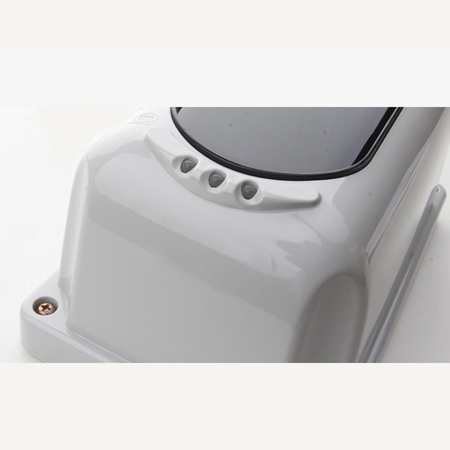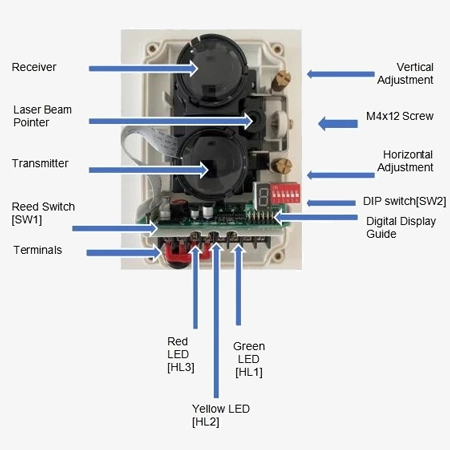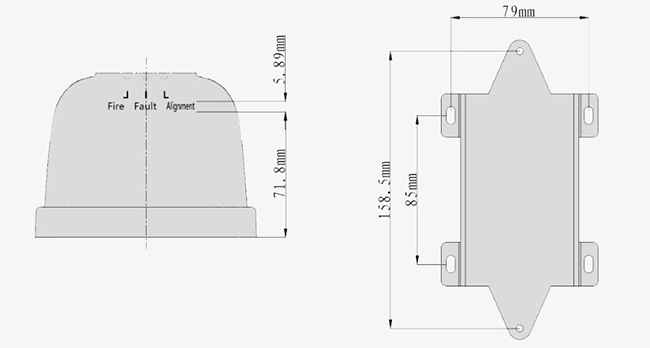SISCO infrared smoke detector has an automatic compensation function, which can automatically compensate for the influence caused by factors such as dust and vibration to a certain extent, thereby improving the reliability of the detector. The infrared flame detector is easy to debug, with a concentric laser module indication, which can easily find the light path, and a digital tube display, which can indicate the intensity of the reflected light.

Sensitivity and distance values can be set on site via a handheld encoder
- The infrared smoke detector’s sensitivity can be adjusted on-site to better suit different environments, such as reducing sensitivity in areas with higher dust levels to minimize false alarms or increasing it in clean areas for quicker response.
- Field-adjustable sensitivity lets users modify detection thresholds based on seasonal or environmental shifts, like increased airborne particles, ensuring reliable performance without frequent recalibration.
- Adjusting sensitivity allows the linear detector to better respond to specific characteristics of larger spaces, such as airflows or temperature changes, supporting accurate smoke detection across a range of conditions.

Linear smoke detector features
- The infrared flame detector has an automatic compensation function, which can automatically compensate for the effects caused by dust, vibration and other factors to a certain extent, improving the reliability of the detector.
- It is simple to debug, with a concentric laser module indicator, which can easily find the light path, and a digital tube display, which can indicate the intensity of reflected light.
- The PCB board is fully sealed and protected.
Dimension

Applications
SISCO smoke detectors are essential safety devices widely used across various spaces, from homes, hotels, and schools to shopping malls to quickly alert people to fire hazards. By detecting smoke early, these detectors help protect lives and property, facilitating quick evacuation and minimizing fire-related risks, making them crucial in enhancing safety and security for occupants in diverse environments.

Home

School

Shopping Mall

Hotel
| Model | SISCO-SMOKE-TX6701 |
| Working Voltage | Power supply current: monitoring current ≤23mA Alarm current ≤33mA Debug current ≤55mA |
| Optical Path Directional Dependency Angle | ±0.5 degrees |
| 3 Sensitivity Level | Level 1 sensitivity alarm threshold 2.6dB Level 2 sensitivity alarm threshold 3.4dB Level 3 sensitivity alarm threshold 4.8dB |
| Fire Alarm and Fault Contact Output | Fire alarm relay: contact capacity 30V/2A, terminals HJ1 and HJ2 are normally open in normal state, and closed in fire alarm state. Fault relay: contact capacity 30V/2A, terminals GZ1 and GZ2 are normally open in normal state, and closed in fault state. |
| Operating Environment | Temperature -10℃~+55℃, relative humidity ≤95%RH, no condensation. |
| Shell Protection Level | When used in ordinary environment, the shell protection level is IP30; When used in special environment, after glue sealing, the shell protection level is IP66. |
| Optical Path Length | 8m~100m |
| Detector Status Indication | Monitoring status: The red indicator light flashes periodically. Debugging status: The green indicator light is always on or flashing. Fire alarm status: The red indicator light is always on. Fault status: The yellow indicator light is always on. |
| Weight | 440g |
Q1: What is a smoke detector?
A1: A smoke detector is a typical device converted from space fire protection measures to civilian use. The smoke detector mainly realizes fire prevention by monitoring the concentration of smoke. The smoke detector adopts ion-type smoke sensor. The ion-type smoke sensor is a kind of advanced technology, stable and reliable sensor, which is widely used in various daily life. Its performance is far better than that of gas-sensitive resistance fire alarms.
Q2: How does a smoke detector work?
A2: The infrared beam of the infrared emission tube is dispersed by the smoke particles, and the intensity of the scattered light is proportional to the smoke concentration. Therefore, the intensity of the infrared beam received by the photosensitive tube will change, and it will be converted into a point signal, which will eventually become an alarm signal.
Q3: What does a smoke detector do?
A3: Smoke detectors assemble sensors, control assemblies, and alarm notifications. Therefore, this is a collection of multi-functional detector in one, is the most suitable for residential. Once the smoke detector is triggered, the device sends a signal to the audio-visual notification device, which will issue an alarm. Inside the smoke detector, you'll find a power source and a built-in sensor that can react to the smoke in different ways.
Tips: How does alignment affect linear smoke detectors?
Alignment is crucial for the reliable performance of linear smoke detectors, as these devices depend on a precise, uninterrupted beam between the transmitter and receiver to detect smoke particles accurately. Even a minor misalignment can interfere with the beam, reducing detection sensitivity and potentially causing the detector to miss smoke or trigger false alarms.
Correct alignment also minimizes the risk of false alarms that may result from environmental factors, such as building vibrations, shifting due to temperature changes, or nearby mechanical systems. When the detector is properly aligned, the light beam remains steady and focused, making it less susceptible to minor disturbances that could otherwise be mistaken for smoke interference.
In the long term, regular alignment checks are essential, as even gradual changes in alignment can reduce the detector’s accuracy and response time. Many modern linear smoke detectors come equipped with helpful alignment aids, such as self-alignment mechanisms, laser guides, or built-in alignment indicators. These features make both installation and recalibration easier, helping maintain optimal detector performance and minimizing interruptions in large open spaces.
Overall, proper alignment supports both effective smoke detection and reduced maintenance needs, ensuring that the detector provides accurate, reliable protection against fire hazards.
Thank you for buying industrial test and measurement equipment on SISCO.com, all products sold by SISCO and the partner cover a 12 months warranty, effective from the date of receiving the products.
What is covered?
SISCO is responsible for providing free spare parts, and free technical support to assist the customer to repair the defective products until the problem is solved.
What is not covered?
- Product purchased from anyone other than a SISCO store or a SISCO authorized reseller.
- Expendable parts.
- Routine cleaning or normal cosmetic and mechanical wear.
- Damage from misuse, abuse or neglect.
- Damage from use of parts other than SISCO approved.
- Damage from use outside the product’s usage or storage parameters.
- Damage from use of parts not sold by SISCO.
- Damage from modification or incorporation into other products.
- Damage from repair or replacement of warranted parts by a service provider other than a SISCO authorized service provider.
- Damage caused by the application environment not meeting the product usage requirements and the failure to perform preventive maintenance.

